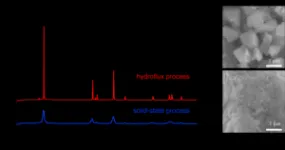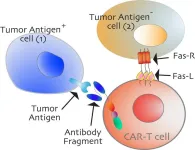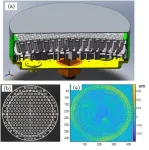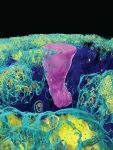(Press-News.org)
Harnessing new advances in genomic surveillance technology could help detect the rise of deadly ‘superbugs’ and slow their evolution and spread, improving global health outcomes, a new Australian study suggests.
Antimicrobial resistance occurs when bacteria, viruses, fungi and parasites change over time and no longer respond to the medicines and chemicals we use to kill them. These ‘superbugs’ make infections harder to treat and increase the risk of disease spread, severe illness and death.
Without significant intervention, global annual deaths involving antimicrobial resistance are estimated to reach 10 million by 2050, with low and middle-income countries bearing the highest burden.
The new study, Genomic surveillance for antimicrobial resistance — a One Health perspective, published in Nature Reviews Genetics, highlights the need for a multifaceted ‘One Health’ approach to the surveillance of antimicrobial resistance in the environment.
The research was led by Distinguished Professor Steven Djordjevic from the Australian Institute for Microbiology and Infection at the University of Technology Sydney, together with researchers from the University of Melbourne and the University of South Australia.
“Antimicrobial resistance is a complex and global threat requiring large-scale, co-ordinated and cross-disciplinary collaboration to tackle,” said Professor Djordjevic.
“Understanding the evolution, emergence and spread of antimicrobial resistance within and between humans, animals, plants and natural environments is critical in mitigating the colossal impacts associated with this phenomenon.”
The use of genomic tracing during the Covid-19 pandemic has provided insight into the potential of genomic technologies to monitor the development and spread of antimicrobial genes and mutations.
“Antimicrobial resistance can occur when microorganisms acquire genetic information, either by mutation, recombination or transfer of antibiotic resistance genes from the bacterial gene pool,” said Professor Erica Donner from the University of South Australia.
“Genomic technologies, combined with AI and machine learning, are powerful platforms for determining resistance trends. They can identify instances where microbes and their genetic material move between different environments, evaluating the impact of intervention strategies.
“The evolution of antimicrobial resistance is a complex process that includes the overuse and misuse of antibiotics, metals and disinfectants in medicine and agriculture, and widely varying standards of water, sanitation and hygiene.”
The paper is a call to action for policymakers, highlighting the need to establish national genomic surveillance programs spanning human health, animal health, agriculture, food and environmental management sectors and to share data at both a national and international level.
“Utilising the technology of microbial genomics in the context of effective cross-sectoral data integration will enhance the understanding of antimicrobial resistance emergence and spread within and across these sectors and identify targeted interventions” said Professor Ben Howden from the University of Melbourne.
The researchers provide practical recommendations to implement genomics-enabled surveillance and mitigation strategies and underscore the need for equitable solutions that allow integration of partners from lower- and middle-income countries.
The recommendations include:
Establishing a national One Health antimicrobial resistance surveillance programme incorporating genomics
Increase antimicrobial resistance awareness and education and foster collaboration
Enhancing laboratory capacity in lower and middle-income countries
Encouraging research and innovation
Strengthening regulation and oversight in agriculture
Improving antibiotic stewardship
“The evolutionary nature of antimicrobial resistance makes it a constantly changing and evolving threat. There is no easy solution, but ongoing genomic surveillance can help us better understand and mitigate this global health challenge,” said Professor Djordjevic.
END
AURORA, Colorado (October 23, 2023) - The burning of sugarcane and rice husks may be releasing a toxicant causing a mysterious kidney disease in agricultural workers, according to a paper out today in the American Journal of Kidney Diseases.
An ongoing epidemic of chronic kidney disease has been observed among manual laborers in hot agricultural communities throughout the world, including along the Pacific coast of Central America, India and Sri Lanka. While heat stress and climate change have contributed to this epidemic, researchers have identified tiny silica particles released from sugarcane ash that can be inhaled or ingested through contaminated drinking water that cause ...
A research team from the UC Davis Comprehensive Cancer Center has identified a crucial epitope (a protein section that can activate the larger protein) on the CD95 receptor that can cause cells to die. This new ability to trigger programmed cell death could open the door for improved cancer treatments. The findings were published Oct. 14 in the Nature journal Cell Death & Differentiation.
CD95 receptors, also known as Fas, are called death receptors. These protein receptors reside on cell membranes. When activated, ...
https://doi.org/10.1016/j.bsheal.2023.08.005
During severe acute respiratory syndrome coronavirus 2 (SARS-CoV-2) infection, activated macrophages, dendritic cells, neutrophils, and natural killer cells are the first defense against infection. These immune effectors trap and ingest the virus, kill infected epithelial cells, or produce anti-viral cytokines. Evidence suggests that aging, obesity, and mental illness can lead to weakened innate immunity and, thus, are all associated with elevated infection and severe disease progression of coronavirus disease 2019 (COVID-19). ...
https://doi.org/10.1016/j.bsheal.2023.08.004
Data on the viral rebound and safety of nirmatrelvir/ritonavir in lung transplant (LTx) recipients are limited. The study prospectively followed four LTx recipients. Clinical characteristics, viral RNA dynamic in throat swabs, and tacrolimus blood concentration were monitored regularly. All four LTx recipients, aged 35–74 years, were not vaccinated against severe acute respiratory syndrome coronavirus 2 (SARS-CoV-2). They got coronavirus disease 2019 (COVID-19) after ...
TORONTO, October 23, 2023 –This year, Canada saw the worst wildfire season in its history, with fires destroying homes, displacing thousands of residents, and burning the largest area since contemporary records began in 1983. Much of this damage to communities could be reduced with better wildfire preparedness – but wildland urban interface (WUI) communities often face significant barriers in implementing these improvements, according to a study by York University’s Disaster and Emergency Management researchers.
According to the study, Determinants of residential wildfire mitigation uptake: A ...
A new publication from Opto-Electronic Advances, 10.29026/oea.2023.230039 discusses diffraction-limited visible imaging for large aperture telescopes.
The deformable mirror used in adaptive optics can change its surface to instantly correct the static wavefront aberration of the optical system and atmospheric turbulence wavefront disturbance. This allows the optical system to automatically adapt to changes in the environment and maintain optimal performance. High-resolution astronomical observation, laser atmospheric transmission, and biomedical imaging all make extensive use ...
Texas A&M University is joining a multi-university team on a major research project to track objects orbiting the moon. The Air Force Research Laboratory is awarding up to $5 million over five years for the Space University Research Initiative (SURI).
“The SURI is an outstanding initiative to train our next-generation workforce. We look forward to carrying out creative research aimed at addressing astronautical challenges in cislunar space,” said Dr. Manoranjan Majji, an associate professor and Josey Family Foundation Faculty Fellow in the Department of Aerospace Engineering at ...
Embargoed for release until 5:00 p.m. ET on Monday 23 October 2023
Annals of Internal Medicine Tip Sheet
@Annalsofim
Below please find summaries of new articles that will be published in the next issue of Annals of Internal Medicine. The summaries are not intended to substitute for the full articles as a source of information. This information is under strict embargo and by taking it into possession, media representatives are committing to the terms of the embargo not only on their own behalf, but also on behalf of the organization ...
In 2021, a team of University of Arizona astronomers suggested that a recently discovered near-Earth asteroid, Kamo`oalewa, could be a chunk of the moon. Two years after the striking discovery, another UArizona research group has found that a rare pathway could have enabled this to happen.
So far, only distant asteroids from beyond the orbit of Mars have been considered a source of near-Earth asteroids, said Renu Malhotra, Regents Professor of Planetary Sciences and a senior author on the paper.
"We are now establishing that the moon is a more likely source ...
A new study by University of Iowa researchers finds that rare lung cells known as pulmonary ionocytes facilitate the absorption of water and salt from the airway surface. This function is exactly the opposite of what was expected of these cells and may have implications for cystic fibrosis (CF) lung disease.
Five years ago, scientists reported the unexpected discovery that ionocytes—a cell type commonly found in fish gills and frog skin—are also present in the lining of human lungs and airways. These pulmonary ionocytes were particularly interesting to CF researchers because although they only account for about 1% of all the cells in the airway ...






